2009 CHEVROLET EXPRESS CARGO VAN instrument panel
[x] Cancel search: instrument panelPage 1 of 408

Seats and Restraint System............................. 1-1
Front Seats
............................................... 1-2
Rear Seats
............................................... 1-6
Safety Belts
.............................................1-10
Child Restraints
.......................................1-30
Airbag System
.........................................1-58
Restraint System Check
............................1-78
Features and Controls..................................... 2-1
Keys
........................................................ 2-2
Doors and Locks
....................................... 2-6
Windows
.................................................2-13
Theft-Deterrent Systems
............................2-16
Starting and Operating Your Vehicle
...........2-19
Mirrors
....................................................2-32
Storage Areas
.........................................2-34
Instrument Panel............................................. 3-1
Instrument Panel Overview
.......................... 3-4
Climate Controls
......................................3-19
Warning Lights, Gages, and Indicators
........3-23
Driver Information Center (DIC)
..................3-41
Audio System(s)
.......................................3-63
Driving Your Vehicle....................................... 4-1
Your Driving, the Road, and the Vehicle
....... 4-2
Towing
...................................................4-25Service and Appearance Care.......................... 5-1
Service
..................................................... 5-3
Fuel
......................................................... 5-5
Checking Things Under the Hood
...............5-12
All-Wheel Drive
........................................5-44
Rear Axle
...............................................5-45
Front Axle
...............................................5-46
Noise Control System
...............................5-47
Bulb Replacement
....................................5-48
Windshield Wiper Blade Replacement
.........5-53
Tires
......................................................5-54
Appearance Care
.....................................5-97
Vehicle Identification
...............................5-104
Electrical System
....................................5-105
Capacities and Specifications
...................5-111
Maintenance Schedule..................................... 6-1
Maintenance Schedule
................................ 6-2
Customer Assistance Information.................... 7-1
Customer Assistance and Information
........... 7-2
Reporting Safety Defects
...........................7-15
Vehicle Data Recording and Privacy
...........7-18
Index................................................................ 1
2009 Chevrolet Express Owner ManualM
Page 17 of 408
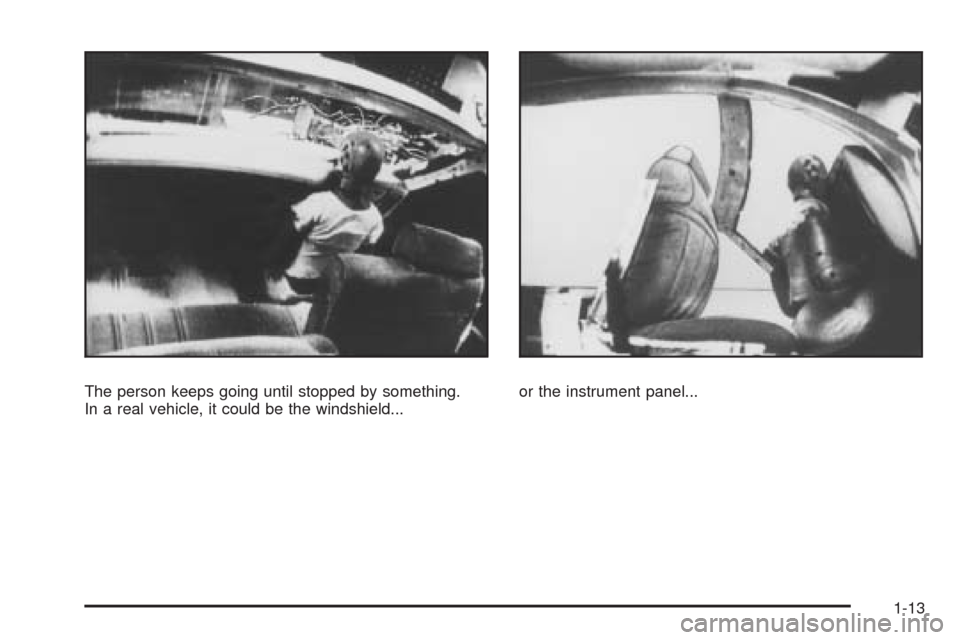
The person keeps going until stopped by something.
In a real vehicle, it could be the windshield...or the instrument panel...
1-13
Page 43 of 408
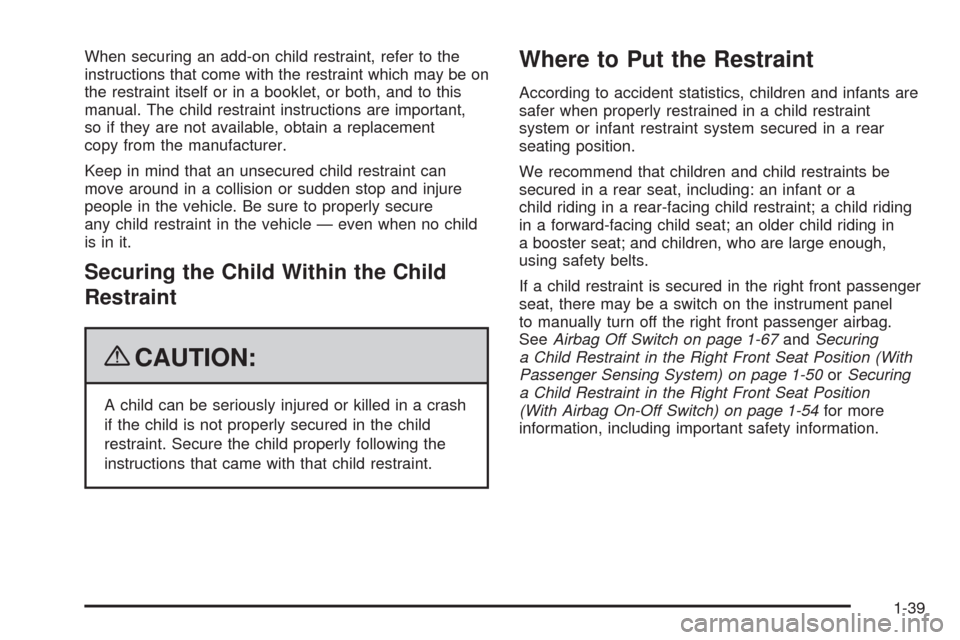
When securing an add-on child restraint, refer to the
instructions that come with the restraint which may be on
the restraint itself or in a booklet, or both, and to this
manual. The child restraint instructions are important,
so if they are not available, obtain a replacement
copy from the manufacturer.
Keep in mind that an unsecured child restraint can
move around in a collision or sudden stop and injure
people in the vehicle. Be sure to properly secure
any child restraint in the vehicle — even when no child
is in it.
Securing the Child Within the Child
Restraint
{CAUTION:
A child can be seriously injured or killed in a crash
if the child is not properly secured in the child
restraint. Secure the child properly following the
instructions that came with that child restraint.
Where to Put the Restraint
According to accident statistics, children and infants are
safer when properly restrained in a child restraint
system or infant restraint system secured in a rear
seating position.
We recommend that children and child restraints be
secured in a rear seat, including: an infant or a
child riding in a rear-facing child restraint; a child riding
in a forward-facing child seat; an older child riding in
a booster seat; and children, who are large enough,
using safety belts.
If a child restraint is secured in the right front passenger
seat, there may be a switch on the instrument panel
to manually turn off the right front passenger airbag.
SeeAirbag Off Switch on page 1-67andSecuring
a Child Restraint in the Right Front Seat Position (With
Passenger Sensing System) on page 1-50orSecuring
a Child Restraint in the Right Front Seat Position
(With Airbag On-Off Switch) on page 1-54for more
information, including important safety information.
1-39
Page 58 of 408
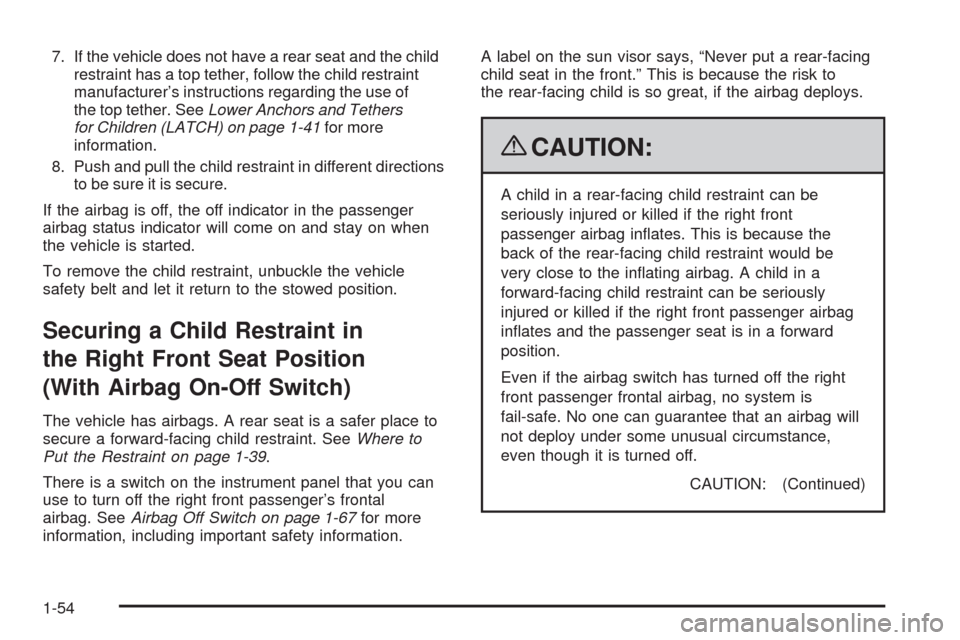
7. If the vehicle does not have a rear seat and the child
restraint has a top tether, follow the child restraint
manufacturer’s instructions regarding the use of
the top tether. SeeLower Anchors and Tethers
for Children (LATCH) on page 1-41for more
information.
8. Push and pull the child restraint in different directions
to be sure it is secure.
If the airbag is off, the off indicator in the passenger
airbag status indicator will come on and stay on when
the vehicle is started.
To remove the child restraint, unbuckle the vehicle
safety belt and let it return to the stowed position.
Securing a Child Restraint in
the Right Front Seat Position
(With Airbag On-Off Switch)
The vehicle has airbags. A rear seat is a safer place to
secure a forward-facing child restraint. SeeWhere to
Put the Restraint on page 1-39.
There is a switch on the instrument panel that you can
use to turn off the right front passenger’s frontal
airbag. SeeAirbag Off Switch on page 1-67for more
information, including important safety information.A label on the sun visor says, “Never put a rear-facing
child seat in the front.” This is because the risk to
the rear-facing child is so great, if the airbag deploys.
{CAUTION:
A child in a rear-facing child restraint can be
seriously injured or killed if the right front
passenger airbag inflates. This is because the
back of the rear-facing child restraint would be
very close to the inflating airbag. A child in a
forward-facing child restraint can be seriously
injured or killed if the right front passenger airbag
inflates and the passenger seat is in a forward
position.
Even if the airbag switch has turned off the right
front passenger frontal airbag, no system is
fail-safe. No one can guarantee that an airbag will
not deploy under some unusual circumstance,
even though it is turned off.
CAUTION: (Continued)
1-54
Page 62 of 408
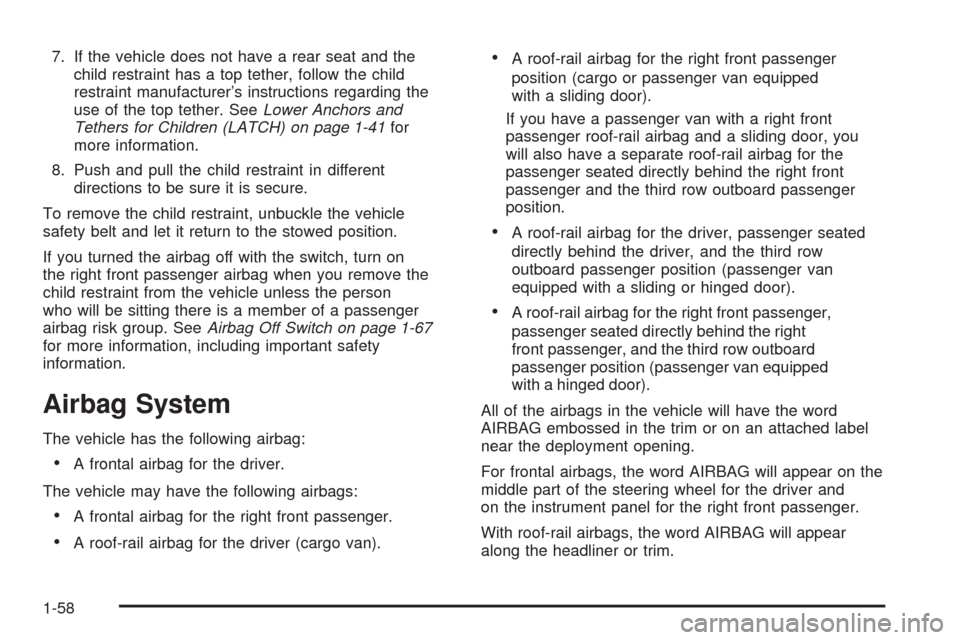
7. If the vehicle does not have a rear seat and the
child restraint has a top tether, follow the child
restraint manufacturer’s instructions regarding the
use of the top tether. SeeLower Anchors and
Tethers for Children (LATCH) on page 1-41for
more information.
8. Push and pull the child restraint in different
directions to be sure it is secure.
To remove the child restraint, unbuckle the vehicle
safety belt and let it return to the stowed position.
If you turned the airbag off with the switch, turn on
the right front passenger airbag when you remove the
child restraint from the vehicle unless the person
who will be sitting there is a member of a passenger
airbag risk group. SeeAirbag Off Switch on page 1-67
for more information, including important safety
information.
Airbag System
The vehicle has the following airbag:
•A frontal airbag for the driver.
The vehicle may have the following airbags:
•A frontal airbag for the right front passenger.
•A roof-rail airbag for the driver (cargo van).
•A roof-rail airbag for the right front passenger
position (cargo or passenger van equipped
with a sliding door).
If you have a passenger van with a right front
passenger roof-rail airbag and a sliding door, you
will also have a separate roof-rail airbag for the
passenger seated directly behind the right front
passenger and the third row outboard passenger
position.
•A roof-rail airbag for the driver, passenger seated
directly behind the driver, and the third row
outboard passenger position (passenger van
equipped with a sliding or hinged door).
•A roof-rail airbag for the right front passenger,
passenger seated directly behind the right
front passenger, and the third row outboard
passenger position (passenger van equipped
with a hinged door).
All of the airbags in the vehicle will have the word
AIRBAG embossed in the trim or on an attached label
near the deployment opening.
For frontal airbags, the word AIRBAG will appear on the
middle part of the steering wheel for the driver and
on the instrument panel for the right front passenger.
With roof-rail airbags, the word AIRBAG will appear
along the headliner or trim.
1-58
Page 64 of 408
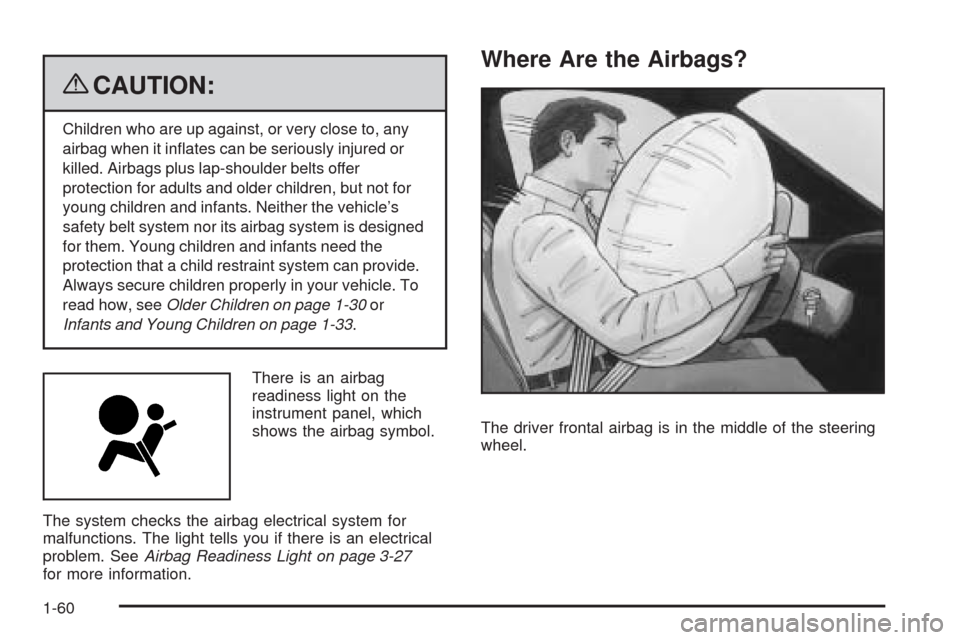
{CAUTION:
Children who are up against, or very close to, any
airbag when it inflates can be seriously injured or
killed. Airbags plus lap-shoulder belts offer
protection for adults and older children, but not for
young children and infants. Neither the vehicle’s
safety belt system nor its airbag system is designed
for them. Young children and infants need the
protection that a child restraint system can provide.
Always secure children properly in your vehicle. To
read how, seeOlder Children on page 1-30or
Infants and Young Children on page 1-33.
There is an airbag
readiness light on the
instrument panel, which
shows the airbag symbol.
The system checks the airbag electrical system for
malfunctions. The light tells you if there is an electrical
problem. SeeAirbag Readiness Light on page 3-27
for more information.
Where Are the Airbags?
The driver frontal airbag is in the middle of the steering
wheel.
1-60
Page 65 of 408
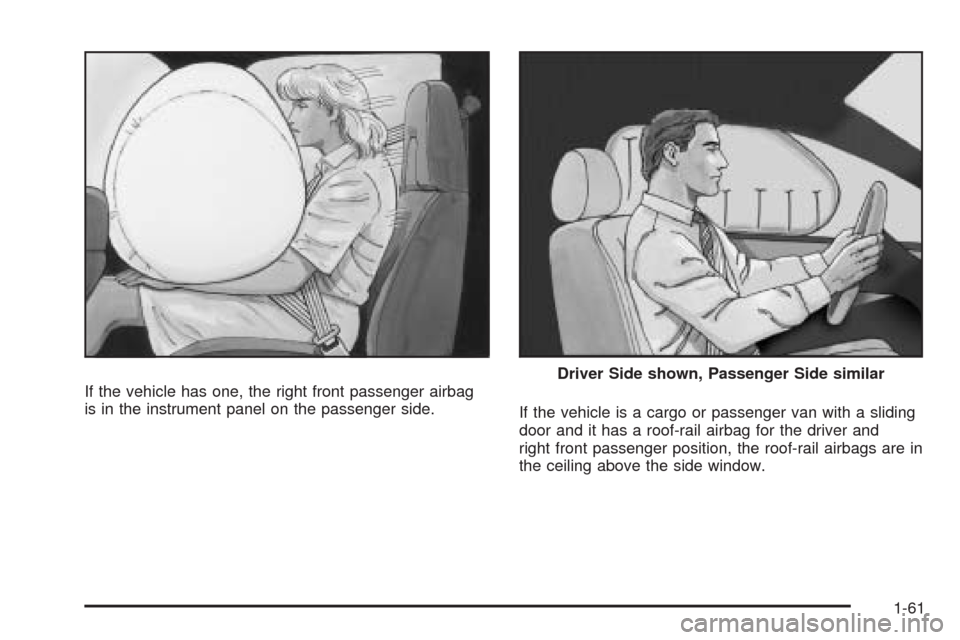
If the vehicle has one, the right front passenger airbag
is in the instrument panel on the passenger side.
If the vehicle is a cargo or passenger van with a sliding
door and it has a roof-rail airbag for the driver and
right front passenger position, the roof-rail airbags are in
the ceiling above the side window.Driver Side shown, Passenger Side similar
1-61
Page 68 of 408

In addition, the vehicle may have dual-stage frontal
airbags. Dual-stage airbags adjust the restraint
according to crash severity. The vehicle has electronic
frontal sensors, which help the sensing system
distinguish between a moderate frontal impact and a
more severe frontal impact. For moderate frontal
impacts, dual-stage airbags inflate at a level less than
full deployment. For more severe frontal impacts,
full deployment occurs.
The vehicle may or may not have roof-rail airbags.
SeeAirbag System on page 1-58. Roof-rail airbags are
intended to inflate in moderate to severe side crashes.
In addition, these roof-rail airbags are intended to inflate
during a rollover. Roof-rail airbags will inflate if the
crash severity is above the system’s designed threshold
level. The threshold level can vary with specific
vehicle design.
Roof-rail airbags are not intended to inflate in frontal
impacts, near-frontal impacts, or rear impacts. All roof-rail
airbags will deploy when either side of the vehicle is
struck.In any particular crash, no one can say whether an
airbag should have inflated simply because of the
damage to a vehicle or because of what the repair costs
were. For frontal airbags, inflation is determined by what
the vehicle hits, the angle of the impact, and how quickly
the vehicle slows down. For roof-rail airbags, deployment
is determined by the location and severity of the side
impact.
What Makes an Airbag In�ate?
In a deployment event, the sensing system sends an
electrical signal triggering a release of gas from the
inflator. Gas from the inflator fills the airbag causing the
bag to break out of the cover and deploy. The inflator, the
airbag, and related hardware are all part of the airbag
module.
Frontal airbag modules are located inside the steering
wheel and instrument panel. For vehicles with roof-rail
airbags, there are airbag modules in the ceiling of the
vehicle, near the side windows for the first, second, and
third rows (if equipped). SeeWhere Are the Airbags? on
page 1-60for more information.
1-64